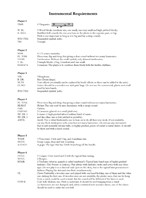
Ubangi Djembe
Composer: Rafael Reina
Instrument: Percussion Ensemble
Level: Advanced
Published: 2008
Price: €44.00
Item details
-
Description +
-
Duration: 16 min.
Although of Spanish nationality, and since 2002 also Dutch, I was born and raised in a former Spanish colony in West Africa called Equatorial Guinea. There I grew up listening to a strange mixture of early Stravinsky, Bartók, flamenco and a wide variety of African drumming and singing.
This combination, from both musical and existential viewpoints, probably shaped my exploration, years later, of non-western cultures, my taste for a music without frontiers or boundaries, as well as my inclination for writing music for percussion and percussive music.
Ubangi is the name of an instrument that I encountered in my native country and Djembe has become almost a symbol of African drum at this point. The title was and is in fact a tribute to my very African roots. In this composition I travel through the polyrhythms, memories and 'flavours' of the African continent - from the deserts of Morocco where Arabic melodies are harmonised with very dissonant chords, to the jungle of Equatorial Guinea whose sounds I can still hear.
This piece was a commission of the Spanish Culture Ministry for the 1992 Contemporary music Festival of Alicante.
-
-
Instrumentation +
-
Percussion Ensemble (6 players)
Player 1:
4 Timpani
3 Wood-Blocks
Bell
Cymbal
Triangle
Player 2:
Marimba
Floor Tom
Tambourine
5 Temble-Blocks
2 Maracas
Player 3:
Vibraphone
Bass Drum
Guiro
Cymbal
Player 4:
Floor Tom
Hi-Hat
Cabasa
2 Castanets
2 Snare Drums
Anvil
Player 5:
4 Tom-Toms
3 Gongs
A gogo
Player 6:
3 Congas
2 Bongos
2 Timbales
Clave
Cowbell
-
-
Watch+
-
About the composer +
-
Rafael Reina was born in 1961 in Equatorial Guinea. At the age of seven he moved to Madrid where he later studied bass guitar. In 1984 he left to Boston to study composition at the Berklee College of Music. Then he studied with, Johannes Fritsch and J.L. de Delás in Cologne.
Since 1992 he travels regularly to Bangalore, India, to explore the theory of Karnatic (South ‐ Indian classical) music with Jahnavi Jayaprakash and N.G. Ravi.
In 1993 he settled himself in Amsterdam where he became lecturer at the Conservatory of Amsterdam in 1995. He developed a four ‐ year programme based on Karnatic music theory with applications to Western contemporary music and jazz.
Rafael Reina bases his compositions since 1993 on the concepts of Karnatic music. The natural tuning, as it is being used in Karnatic music, is so subtle and nuanced that Reina feels compelled to use more pitches than those in the tempered 12 ‐ tone system.
To approximate the Karnatic concepts he mostly makes use of the tempered quarter ‐ tone system, and of special instrumental techniques and non ‐ traditional sounds. Next to these, he tries to incorporate also non ‐ western instruments in many of his compositions.
He has composed three operas: Two in collaboration with Petra Weimer ('Wolfli, a journey into chaos' and 'HesseIndia') and one with the conductor/ percussionist Josep Vicent, called '1714, Mon de Guerres'.
He has also composed a lot of chamber music, that has been performed in the Netherlands, Germany, Austria, Belgium, Rusia, United States, England, Australia, Taiwan, India and Spain.
-
-
Reviews +
-
Review (Percussive Notes, July (60) 2012)
The composer of this work states that he “was born and raised in a former Spanish colony in West Africa called Equatorial Guinea. There I grew up listening to a strange mixture of early Stravinsky, Bartok, flamenco, and a wide variety of African drumming and singing.” That mixture, along with a touch of inspiration from Varèse and “Ionisation,” is a good description of this exciting work for percussion ensemble.
The score provides descriptions of many of the instruments, along with substitutions for some of the more exotic ones. Each part comes with a photo of the multiple percussion setup so each player can easily see what the composer had in mind. This is particularly helpful for the large groups of instruments played by one player.
This complex work is full of mixed meter, rhythmic fragments, odd meters, odd note groupings, and polyrhythmic passages. The dynamics are notated in a very detailed way and must be adhered to for a musical performance. Each part is extremely independent, but there is usually some kind of repetitive groove going on. The marimba and vibe parts tend to be quite angular and require four-mallet technique. Several places in the composition, the dynamics rise to a high level with all the instruments playing, only to abruptly change to a quiet, thin-textured section. The piece ends with unison rhythms played at an ffff dynamic level.
This work is advanced and will take a lot of work for most ensembles to prepare for performance. But the efforts will pay o# both educationally and aesthetically, as the players will gain much rhythmic stability, confidence, and musical reward in the process.
—Tom Morgan
-
-
Credits +
-
Photo: Vanessa Goad
Front cover graphics and layout: Ronni Kot Wenzell
Printed in Copenhagen, Denmark
Copyright © Edition Svitzer
www.editionsvitzer.com
-

